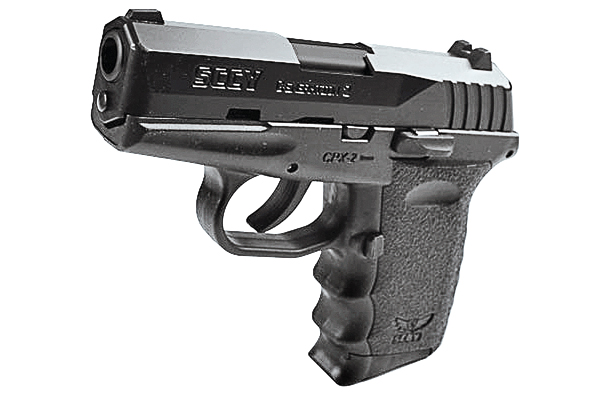At first glance, “pocket pistol” is a straightforward term that leaves little to the imagination. But its important to remember that pockets come in all sizes and in more than one place—hip pocket, back pocket, cargo pants thigh pocket. And don’t forget jacket pockets—that’s where the majority of small handguns were carried for the better part of the late 19th and early 20th centuries. Today, the only limitation is determining what caliber you are most comfortable with, from .380 ACP semi-autos to heavy-hitting 9mm, .40 S&W and .45 ACP models. Of course, carrying a pocket pistol for self defense isn’t limited to pocket holsters; the same gun will easily fit in a belt holster, inside the waistband (IWB) or an ankle holster. The underlying consideration is finding the handgun and caliber that will work best for you, regardless of carry method. Read on for four tips to finding the right subcompact autopistol to fit your personal defense needs.
Ease of Carry

Your concealed-carry handgun must meet certain common-sense requirements. First and foremost, the gun has to be one you can handle. It has to be right for your hand size and physical strength, and you have to be able to manage the recoil and get it back on target quickly. Here’s a simple test to determine ease of carry. Lay the gun down on a table and see if you can cover it entirely with your open hand. Hand sizes vary, and that’s what makes this so important. If you can cover the gun, you can easily hold it, and if your hand fits into your pocket, so will the gun. This isn’t to say a slightly larger pistol won’t work (as some clothing has larger pockets), but every compromise adds to the complexity of concealment. Remember, this is not a target pistol; it is your last option in a life-threatening situation, and usually under the worst circumstances and at a close distance.
Advertisement — Continue Reading Below
Single Action vs. Double Action

Keep in mind that while double-action-only (DAO) is one of the safest designs for concealed carry, it also demands the most effort to shoot because the trigger has the double duty of both cocking and firing the gun. A SAO (single-action-only), which comprises the majority of small-caliber models, uses a manual safety that has to be released before the gun will fire. The only exception is Glock or Glock-style trigger safety systems. The advantage with either is that an SAO is already cocked and trigger pull is substantially less, making it easier for the majority of people to fire the weapon accurately. With Glock-type safety systems the striker is pre-tensioned, making trigger effort mild to moderate (about 5.5 pounds). These fundamental operating methods apply to every caliber of semi-auto pocket pistol.
Chamberings
Advertisement — Continue Reading Below

The most popular concealed-carry guns are .380 ACPs because they are small and easy-to-carry. Capacity is usually six rounds in the magazine, plus one chambered. Seven rounds of modern defensive .380 ACP cartridges like Hornady Critical Defense 90-grain FTX, Federal Premium Personal Defense Low Recoil 90- grain Hydra-Shok JHP or Speer Gold Dot 90-grain HP offer higher velocities and greater stopping power than older, traditional FMJ .380 ACP rounds. These vast improvements in ballistic performance have given the .380 ACP a level of effectiveness that is nearly on par with today’s 9mm pocket pistols.
If you’re interested in stepping up to the venerable .45 ACP, the available options have improved beyond subcompact 1911s. In the past few years, new technology has allowed for lightweight, polymer-framed .45 ACP semi-autos that are smaller than any 1911 and just slightly larger than a 9mm pocket pistol. They will easily disappear into a trouser pocket, but their capacity is usually limited to 5+1. If one is proficient with larger calibers a .45 ACP still has no equal.
Carry Options
Advertisement — Continue Reading Below
Once you have a pistol that fits your needs and capabilities you need to decide on how to carry it. Consider a variety of positions as a pocket pistol that is accessible from a standing position will be difficult to reach while sitting. From my experience, a subcompact semi-auto will fit comfortably in a compact belt or paddle holster, or a Sneaky Pete (looks like a smartphone case) worn at the four o’clock position, just behind your hip bone. Even if you’re short waisted and a little heavy, the gun will fit comfortably most of the time, allow quick access standing or sitting, and be easily covered by almost any outer shirt or jacket. Next to that, a pocket holster is the most unobtrusive means of concealed carry and allows quick access, unless you’re sitting.
There is one other very practical option that is foolproof for concealment, an IWB holster. The IWB is also the most demanding to wear because it places the entire gun between your pant waist and your body. If you are trim and fit, that’s going to work every time. When you start deducting your own physical limitations (and we all come in different sizes and shapes, so there’s nothing to feel bad about here) the IWB can become the most uncomfortable holster of all. If you can get past that, it is also the most concealable outside of a pocket holster.







































